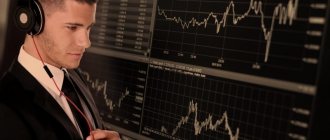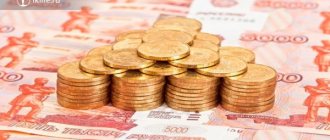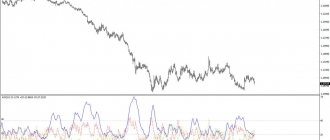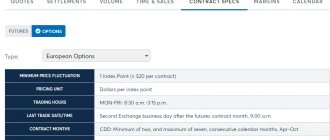Why do traders love financial markets? Because here everyone can find a suitable way to earn money. People with the temperament of impulsive “sprinters” choose scalping and make a profit by spending one to several hours a day in extreme stress mode. And for those who are not fast in their reactions, but have endurance and patience, medium-term trading is suitable.
We’ll look at what it is in today’s review. And since you already know about pipsing and intraday trading, it will be easy to compare the pros and cons.
⇐ Pips on Forex Everything you need to know about intraday trading ⇒
Medium-term trading: distinctive features
As you already understood from the name, this style of trading is distinguished by the period for which the transaction is concluded. If, when pipsing, a position is held for several minutes, or even seconds, during day trading - within one day, then medium-term trading on Forex involves maintaining a trading position from several days to one or two weeks.
What are the benefits of this approach:
1. During the day, a small amount of time is spent on trading.
2. A trader may have less than a dozen transactions per month (depending on the starting capital and the market situation), but each of them will bring a profit of several hundred points.
3. This style of trading is emotionally calmer.
Medium-term trading is suitable for those traders who have a primary job in another area and whose time for trading is limited. In this case, less than an hour a day will be enough to make an analysis and forecast, select potential entry points into the market, open trades when a signal is generated, and then lead these positions to the result.
Sergey Zabotkin talks about making money on stocks in the medium term at his regular webinars on the Gerchik & Co. Youtube channel.
What do traders trade?
The main instruments for trading are securities, currencies, futures contracts and commodities. Let's take a closer look at each category.
Securities
Here, first of all, we mean shares of various companies.
Sample list of securities in my trading terminal
Shares have good liquidity; they can rise or fall significantly in price, especially liquid shares of the so-called “blue chips”, i.e. leading companies.
Securities also include bonds or indices. Bonds are generally less liquid than stocks. There are practically no strong movements, but they are more reliable as an investment tool.
Setting up bonds as a trader in the Quik trading terminal
Indexes represent a portfolio of several securities; on the graphs you can see the average price fluctuations of these securities.
In addition, you can make money on stocks by receiving dividends, the so-called passive income. Dealing with securities takes place on stock markets.
Currency
In this case, the trader does not buy securities issued by companies, but real money from foreign countries. In other words, currency. The value of one currency in relation to another, for various reasons, is constantly changing, this allows traders to make money.
Setting up currency charts by a trader in the Quik trading terminal
For example, it can be assumed, due to the risk of sanctions, that in the near future the ruble will become cheaper against the dollar.
To make money, I need to buy dollars on the foreign exchange market for rubles, wait for the market to move, and then, if I correctly predicted the movement of currencies, sell it and thus earn money on the difference.
Fixed-term contracts
This type includes futures and much more.
Futures are an agreement between parties to sell or buy a specific commodity in an agreed quantity and time frame. The goods are not paid for until delivery; the parties are also responsible for its fulfillment.
List of futures in my trading terminal
The conclusion of such a contract usually does not have the purpose of actually purchasing the subject of the transaction, being a subject of speculation. More details about futures here.
Raw materials and goods
Everything here is clear from the names. The subject of the transaction can be various metals: platinum, palladium, silver, gold.
Raw materials: butane, fuel oil, oil, gasoline.
Cereals: wheat, oats, corn, barley.
Textile raw materials, animals and much more. The cost of these goods also fluctuates constantly, which allows traders to make money.
What is medium-term Forex trading
What type of markets is medium-term trading suitable for? In fact, for anyone. In the medium term you can trade stocks, currencies and even raw materials (oil, gold). Medium-term Forex trading means holding transactions open from several days to 1-2 weeks.
For a successful result you need:
1. Application of fundamental analysis. The monetary policy of central banks, their meetings, and the publication of important macrostatistics influence the direction of currencies and must be taken into account.
2. Entry into a transaction is carried out on the basis of technical analysis. It must be carried out from the monthly timeframe to the working one. Trading itself is carried out on a daily or four-hour interval.
3. When opening a position from strong technical levels, a medium-term strategy can produce transactions with a risk-to-reward ratio above 1:4, sometimes even 1:10.
4. The only disadvantage of long-term Forex transactions is swaps for moving a position overnight.
How traders differ from investors and analysts
If you perceive trading as speculative trading, then the main earnings will be due to the difference between buying and selling, or vice versa, depending on how you trade.
Traders working in financial organizations, accordingly, manage the finances of a certain company and receive monetary remuneration from it in the form of a commission on earnings.
Investors invest money in order to receive passive income or increase capital by investing it in a business (while not managing it themselves). Investors can also purchase securities: stocks, bonds, etc., forming their investment portfolio.
The purpose of such acquisitions will also be to generate income from dividends or other regular payments.
Analysts make money by studying and analyzing situations in markets, in the state and in the world as a whole. They give recommendations on investing funds and choosing the appropriate instrument.
Important! At the same time, they themselves do not participate in trading on the market or investing (or participate privately). And they are not responsible for your lost money on the exchange, thanks to their recommendations!
In fact, all these divisions are quite arbitrary, because traders can quite successfully combine trading on the stock exchange and investing.
Is this necessary though?
I'm just doing trading for now and that's enough for me.
Medium-term Forex trading: strategies
The best medium-term Forex trading strategies focus on finding market entry points with minimal risk and maximum profit potential. How can we identify them?
Most often, trading strategies based on strong price levels are used. The range of work of large players who move prices in the market is wide. And if you enter a position at the beginning of it, you can get big profits with little risk.
But how to determine these levels? To do this, it is important to monitor the accumulation of position volumes on the Chicago CME Exchange. Or take a simpler route - use the Real Market Volume indicator. It automatically analyzes the volumes and prices of trades of market “whales” and shows strong support and resistance levels on the chart.
How traders traded and how they trade now
During the period of the formation of exchange trading, traders physically had to visit exchanges and trade there. Many stock exchange buildings are still preserved and functioning, for example, such famous stock exchanges as Frankfurt, London, New York, etc.
But now the situation has changed a lot. And this is an opportunity for ordinary people!
Traders do not need to go anywhere; all they need is a computer with Internet access and a special trading program (trading terminal), for example QUIK.
Your location doesn’t matter now, as long as you have the Internet!
The trader sends commands to his broker through the trading terminal, and then controls its execution and monitors developments on the exchange.
The command is sent to the broker by the trader through these windows. And control is carried out right there.
The functionality of the trading program allows you to not even be constantly at the computer screen, but to set the necessary orders (orders) to sell or buy. When the specified parameters are reached, the program will automatically execute your order.
My order was executed through the exchange broker. The status is “Completed”, which confirms my will as a trader
Do you agree? Now everything is much simpler!
Medium-term trading: summing up
The main benefits of trading in the medium term are the low investment of time and energy in opening positions and maintaining them. The main thing is to find the right entry points into the market with high profit potential (power reserve).
There is no need to reinvent the wheel here. Track strong price levels and market direction with the Real Market Volume indicator. Also remember to follow risk management and protect your positions with stop loss and take profit.
Control your trading risks wisely, connect the Risk Manager from Gerchik & Co! Find out more about the service
Why is trading needed?
If we talk about the trader’s personal goals, then this is, of course, making a profit.
He is not guided by any other aspects.
This job is no worse or better than others, only the amount of earnings here directly depends on personal skills and knowledge, and career leaps, as well as failures, occur much more often.
On a global scale, a trader is a person who directly influences the world economy; in this case, I’m talking about traders working for large banks and investment management funds.
The market operates according to the main rule: the greater the demand for a product, the higher its price. The same is true in reverse.
The international market determines not only the value of commodities or shares of large companies, but also currencies.
The more attractive a country’s economy is, the more investment the state will attract into it and the higher the value of its currency.
The main market makers, that is, those who set prices and influence their exchange rates, are the central banks of different countries.
By injecting or withdrawing huge amounts, they can lower or raise the price of a currency.
Ordinary, private traders, of course, do not have such influence, but in the aggregate, their actions also affect the economy.
Who teaches online trading - review of the TOP 3 companies with available training programs
Here we come to three brokerage firms that offer the best online trading training.
Choose from these three - you can't go wrong.
1) Alpari
A broker with whom I cooperate personally. The company began operating in 1998 and is now one of the industry leaders. Alpari offers traders to speculate in currencies on the Forex market.
I recommend that you first watch the “Basic Course” in training programs. It is taught by professional traders from different cities - classes are not held at the same time, but differ slightly in content.
2) Nefteprombank
On the website you will find the “Trading Video Courses” tab - the same basic course. All video lessons are free. There is also an “Electronic textbook”, but there is little information in it, only the very basics.
Individual training is available, lasting from 8 to 45 hours, the cost is from 10 to 45 thousand rubles. Classes are held either in person in Moscow or online.
After the video lessons, it’s better to download a good book on trading on the Internet, for example A. Elder’s bestseller “How to Play and Win on the Stock Exchange.”
3) FENIX
Institute of Trading and Investments "PHOENIX" is a serious company. Here the training is paid and it costs a lot of money. Beginner traders sign up for the “Start Up” training programs, and more experienced traders sign up for the “Intensive” training programs.
Training for each program costs 100,000 rubles . VIP clients receive knowledge for free .
On the one hand, it is expensive and in-depth, on the other, I skimmed over the structure of the course and came to the conclusion: most of the material can be obtained for free if desired.
Indicator analysis - all indicators existing in MetaTrader are described in detail on the Internet. Candlestick analysis - even more so: there is nothing complicated in the candlestick models “Hanging Man”, “Shooting Star”, “Clearing in the Clouds” and others.
Therefore, I strongly advise you to first study everything that is free, and only then invest money. I direct you to my previous article “Training to Trading” - there you will find some more practical tips.











